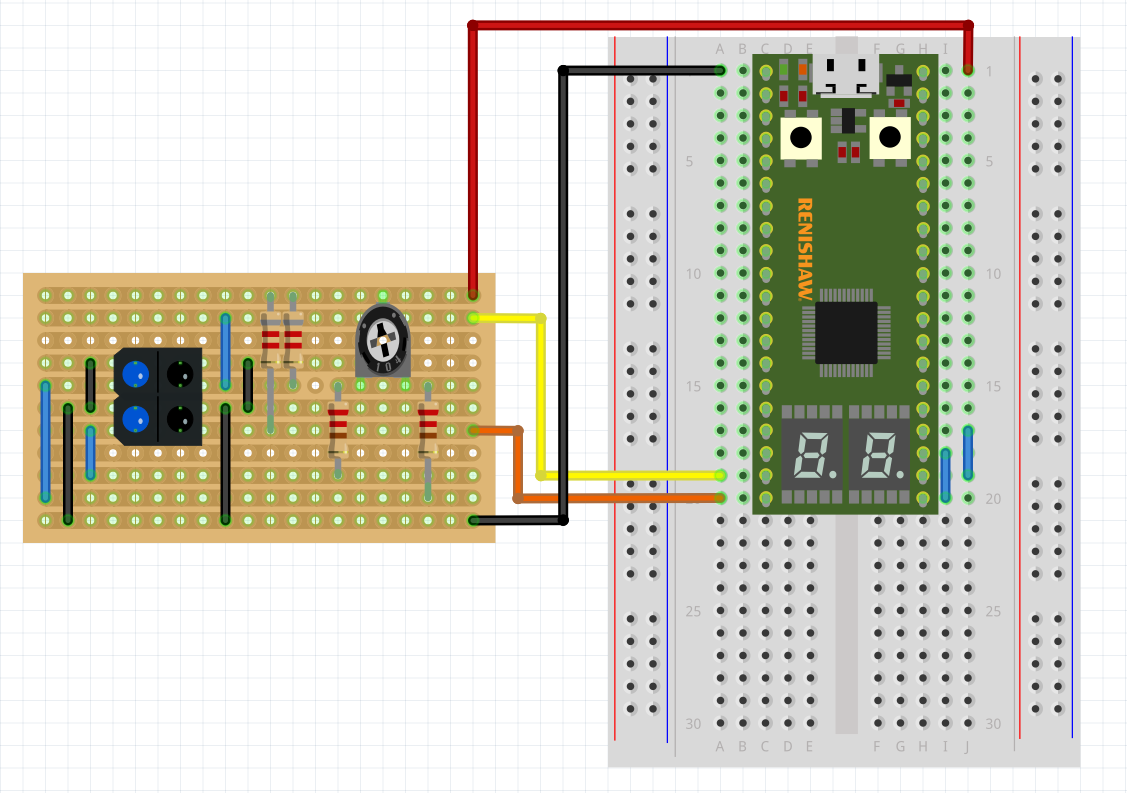Interface the RenBed with a simple optical linear encoder, using X1 encoding.
Dependencies: SevenSegmentDisplay mbed
This is an example of a copper strip-board design for an optical linear encoder (IRED), and how it is wired up to the Renbed on a breadboard:

The trimmer potentiometer is used to vary the current through the IRED LEDs, in order to balance out the two output signals.
main.cpp
- Committer:
- elijahorr
- Date:
- 2016-09-05
- Revision:
- 0:c71cc517659b
- Child:
- 1:83e238178956
File content as of revision 0:c71cc517659b:
#include "mbed.h"
#include "SevenSegmentDisplay.h"
// define values for high and low analog signals, used to compare to ADC values. 0.56 indicates that the low level is set to 56% of 3.3V.
#define SIGNAL_LOW 0.56
#define SIGNAL_HIGH 0.60
class Encoder{
public:
/****************************************************************************************************************
* Encoder - class constructor, used to declare an instant of the Encoder class. *
* *
* Parameters: PinA - analog channel A, PinB - analog channel B, OutputA - digital output for channel A, *
* OutputB - digital output for channel B, InputA - input for the feedback of digital channel A, *
* InputB - input for the feedback of digital channel B *
* *
* Returns: none *
****************************************************************************************************************/
Encoder(PinName pinA, PinName pinB, PinName OutputA, PinName OutputB, PinName InputA, PinName InputB) :
SignalA(pinA), SignalB(pinB), SquaredA(OutputA), SquaredB(OutputB), SquaredA_in(InputA), SquaredB_in(InputB){
//attach ADC function to ticker, will be called every 75 microseconds (pretty much as often as possible)
ProcessCycle.attach_us(this, &Encoder::ConvertSignals, 75);
//attach rising_A function to rising edge interrupt on the feedback signal for digital channel A
SquaredA_in.rise(this, &Encoder::rising_A);
//attach falling_A function to falling edge interrupt on the feedback signal for digital channel B
SquaredA_in.fall(this, &Encoder::falling_A);
}
/*******************************************************************************
* get_count - returns the current encoder counter value
*
* Parameters: none
*
* Returns: int - current counter value
*******************************************************************************/
int get_count(void){
return count;
}
private:
AnalogIn SignalA; //analog input for signal A
AnalogIn SignalB; //analog input for signal B
DigitalOut SquaredA; //digital output for the digital translation of channel A
DigitalOut SquaredB; //digital output for the digital translation of channel B
InterruptIn SquaredA_in; //interrupt for the feedback of digital channel A signal
InterruptIn SquaredB_in; //interrupt for the feedback of digital channel B signal
Ticker ProcessCycle; //ticker to attach signal converter function to
int count; //variable to store counter value
/*******************************************************************************
* ConvertSignals - converts the analog signals from the encoder into digital
* quadrature signals.
*
* Parameters: none
*
* Returns: none
*******************************************************************************/
void ConvertSignals(void){
//take readings from the ADC
float A_reading = SignalA;
float B_reading = SignalB;
//decision algorithm to decide when to set the digital signals high/low,
//SIGNAL_LOW and SIGNAL_HIGH are user defined high and low for the analog signals
if(A_reading < SIGNAL_LOW){
SquaredA = 0;
}
else if(A_reading > SIGNAL_HIGH){
SquaredA = 1;
}
if(B_reading < SIGNAL_LOW){
SquaredB = 0;
}
else if(B_reading > SIGNAL_HIGH){
SquaredB = 1;
}
}
/*******************************************************************************
* rising_A - interrupt function for rising edges on channel A, decides when
* the count should be decremented.
*
* Parameters: none
*
* Returns: none
*******************************************************************************/
void rising_A(void){
if(SquaredB.read() == 0){
count--;
}
}
/*******************************************************************************
* falling_A - interrupt function for rising edges on channel A, decides when
* the count should be incremented.
*
* Parameters: none
*
* Returns: none
*******************************************************************************/
void falling_A(void){
if(SquaredB.read() == 0){
count++;
}
}
};
/* Create an instance of the class Encoder, which will be called lollipop (because of the lolly stick height control).
* Pins must be given in the order specified in the constructor, and analog inputs must be ADC pins */
Encoder lollipop(P0_15, P0_22, P0_17, P0_7, P1_14, P0_1);
SevenSegmentDisplay display(INSTANT); //create instance of SevenSegmentDisplay to drive the 7 segs
/*******************************************************************************
* main - this is the main program routine. The encoder class is working in the
* background, as the constructor was called above.
*
* Parameters: none
*
* Returns: none
*******************************************************************************/
int main(){
//a while loop with the parameter 1 will always execute, and repeat forever
while(1){
int counter = lollipop.get_count(); //get the current encoder count value
// if the counter value is positive, seperate into individual digits and drive displays
if(counter >= 0){
display.FadeMode(INSTANT);
int first_digit = counter/10;
int second_digit = counter%10;
display.DisplayDigits(first_digit, second_digit);
}
//if the counter value is negative, make the display flash while displaying value
else if(counter < 0){
display.FadeMode(FLASH);
display.FlashRate(500);
counter = counter*-1;
int first_digit = counter/10;
int second_digit = counter%10;
display.DisplayDigits(first_digit, second_digit);
}
wait(0.2);
}
}